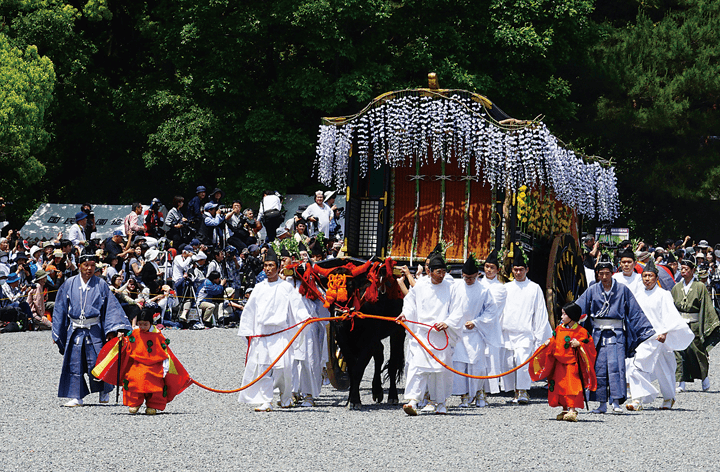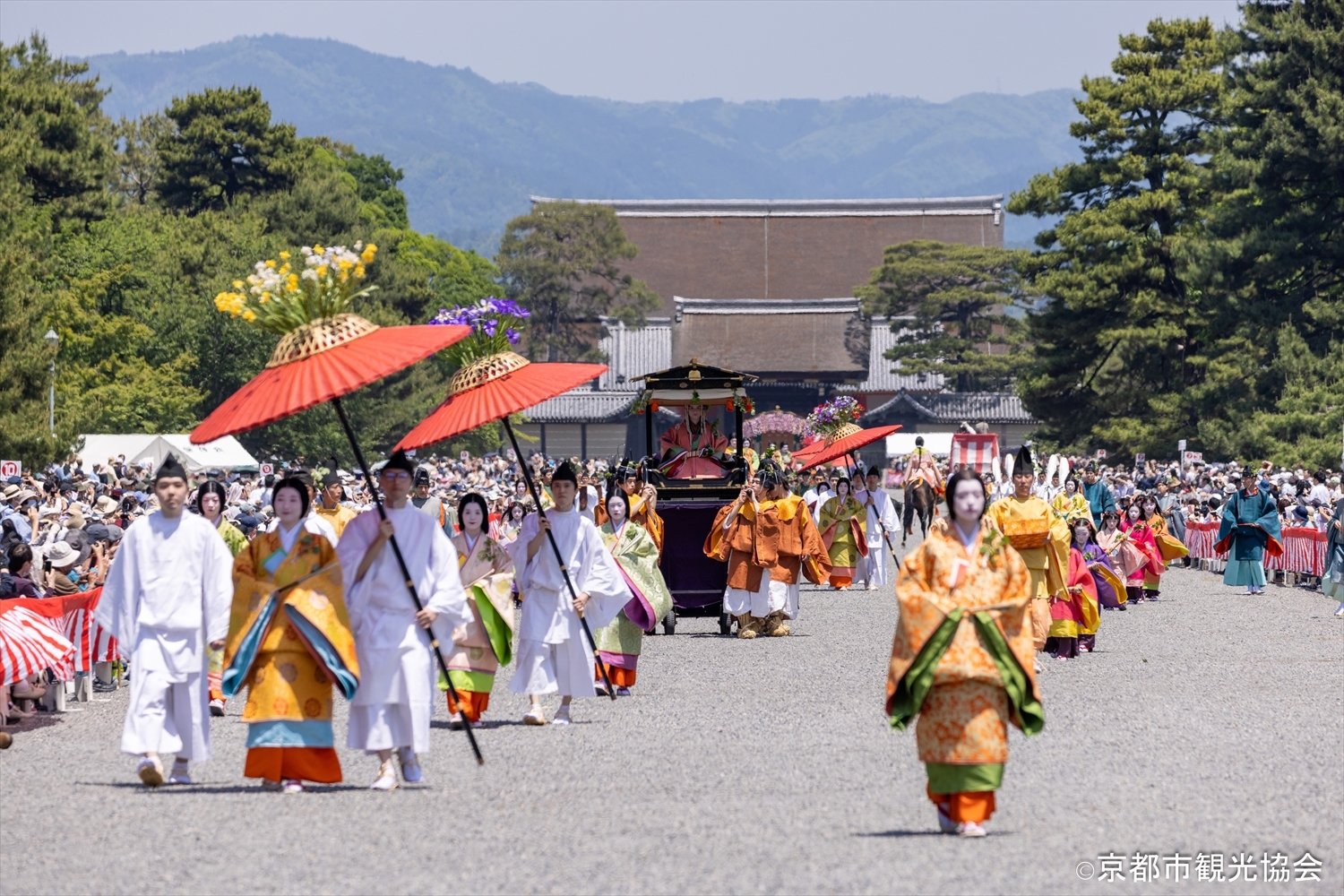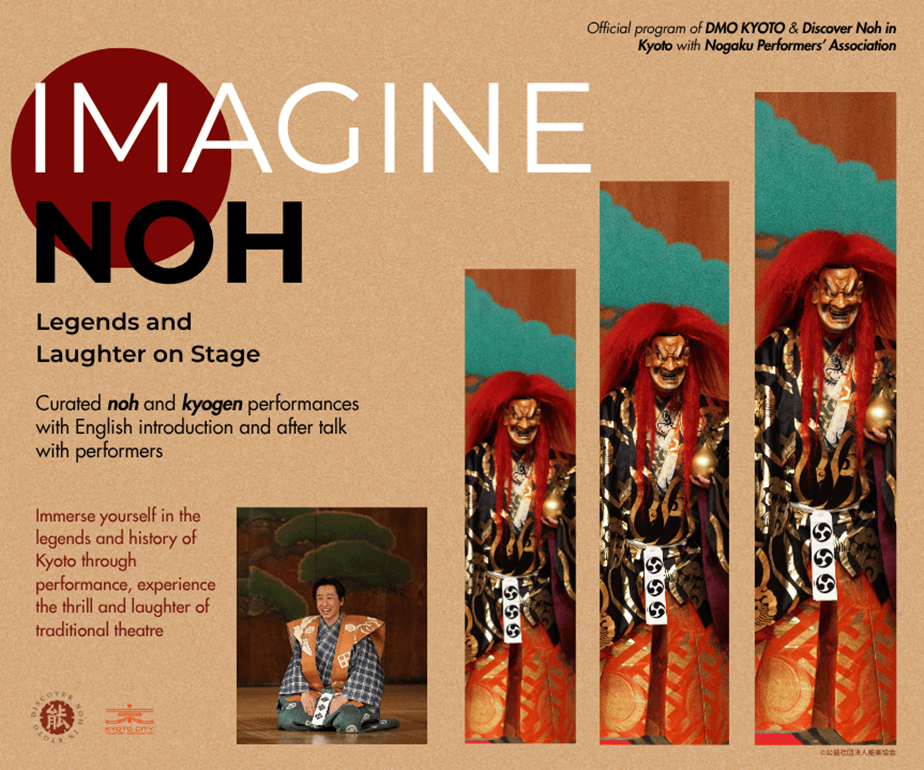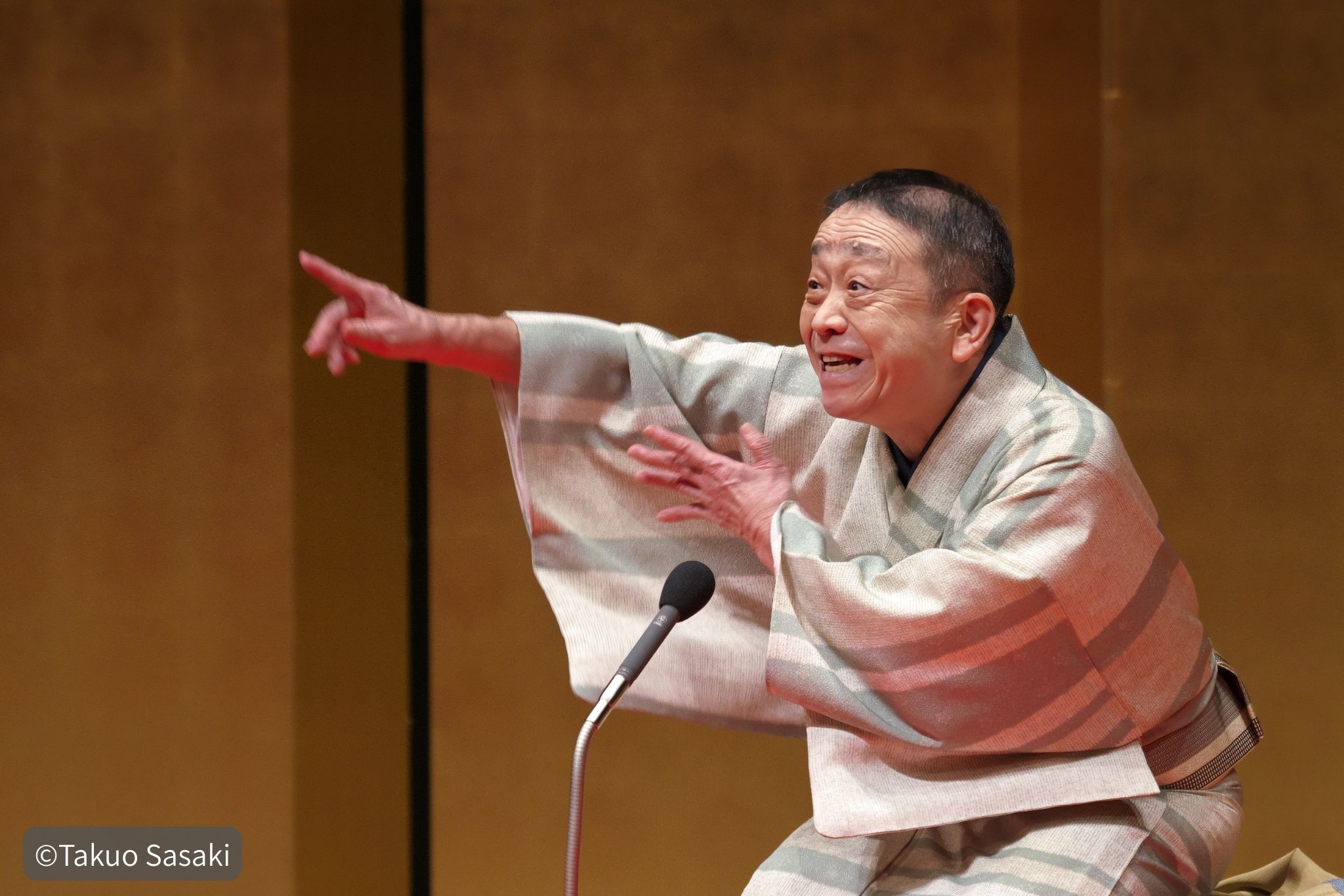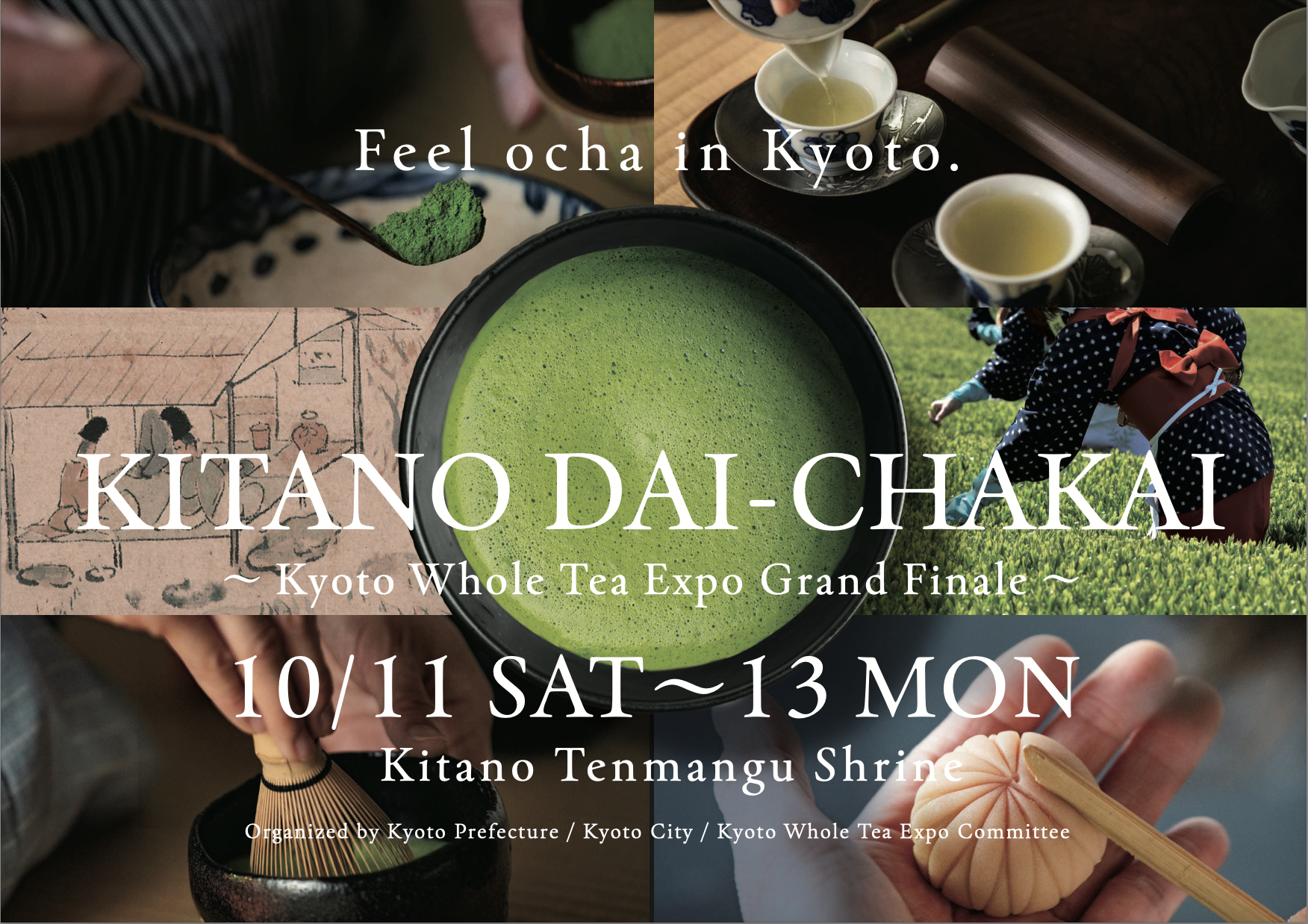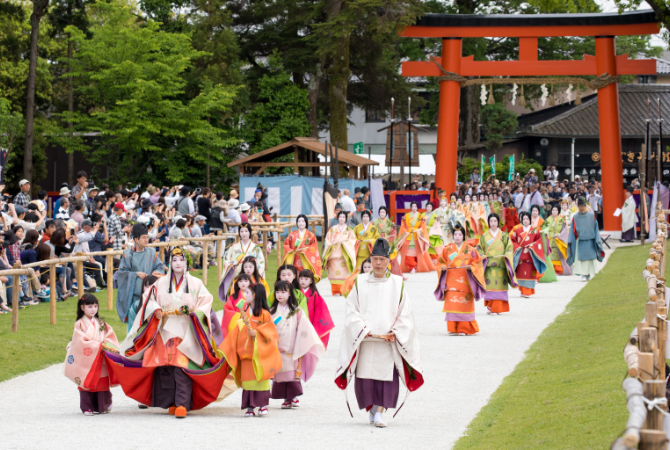
What is the Aoi Matsuri Festival?
Aoi Matsuri (formally named Kamo Matsuri), is an annual festival of the two shrines – Kamigamo-jinja and Shimogamo Jinja. The festival was created as a ritualized petition to the shrine deities for the safety and wellbeing of the state and its people. Aoi Matsuri culminates in a procession held on May 15, just as the fresh growth of spring plants reaches its peak. The event has received its name from the Aoi leaves (hollyhock leaves) that were used to decorate almost everything from shrine buildings, imperial carriages, apparel and headwear, to oxen and horses during it. Today much work is put into the conservation of this particular variety of hollyhock, called futaba aoi, in order to ensure the preservation of the tradition far into the future.
It is one of the most solemn and graceful festivals in Japan and it has been well preserved throughout the ages since the 6th century. From the viewpoint of the history of Japanese manners and customs, it is a very valuable reminder of the past since it has faithfully followed the old customs.
The most notable feature of this fete is the Imperial Messenger’s Procession consisting of an opulent carriage pulled by an ox, flowered umbrellas, courtiers and court ladies in traditional costumes which bring the image of the Heian period’s (794-1185) imperial court back to life.
Origin
In the reign of the Emperor Kinmei (the 6th century), the people suffered from terrible storms and consecutive crop failures that raged throughout the country. The Emperor ordered the diviner Urabe Ikiwahiko to discover the cause, which was then deemed to be a punishment enacted by the deities. Learning of this, the Emperor dispatched an Imperial Envoy to conduct a ritual to appease the Kamo deities. The rites performed to do so have formed the Aoi Matsuri festival. In 807, during the Heian period, it became the Imperial Envoy Festival (a festival conducted by an Imperial Envoy on behalf of the Emperor). The Aoi Matsuri has been passed down for more than a thousand years. Wars, social upheavals and other circumstances forced its suspension many times. However, through the effort and support of the people and many institutions, including the Imperial Court, the Shogunate and shrines; it has always been revived.
Functions
The fete consists of two rituals: Roto-no-Gi (Procession) and Shato-no-Gi (The ritual held on the shrine premises).
Roto-no-gi roughly translates into “Road Ritual”. When the procession arrives at the shrines Shimogamo-jinja and Kamigamo-jinja, a Shrine Ritual is held before the deity at each shrine. During the Shrine Rituals, the Imperial Envoy reads out the Imperial Script and dedicates sacred implements to the deities. A series of rituals is then performed in turn in accordance with ancient tradition. These include two horses circling the shrine dance pavilion three times, ceremonial dance performed to Court music and a galloping horse ritual.
The procession is well-known for its size; it consists of 511 people, 36 horses, 4 oxen and 2 Gissha (carriages). The procession runs 1 kilometer from front to back. Since old times the people of Kyoto have swarmed by the thousands along its routes and have enjoyed watching the elegant ritual.
About the Aoi Matsuri Festival Procession
At 10:30 a.m. the procession starts from the Imperial Palace in accordance with a time-honored form. It is made up of two parts : the imperial messengers’s retinue and the Saio-Dai, a young woman who in the Heian period was an imperial princess.
The Route of the Procession
May 15(In case of rain postponed to 16)
Kyoto Imperial Palace(10:30)→Sakaimachi Gomon Gate→Marutamachi-dori St.→Kawaramachi-dori St.→Shimogamo Jinja Shrine(Ar.11:40)→ Shimogamo Jinja Shrine(Lv.14:20)→Shimogamohondori St.→ Rakuhoku Highschool(14:40)→Kitaoji-dori St.→Kitaoji Bashi Bridge(14:55)→ Kamigamo Jinja Shrine(Ar. 15:30)
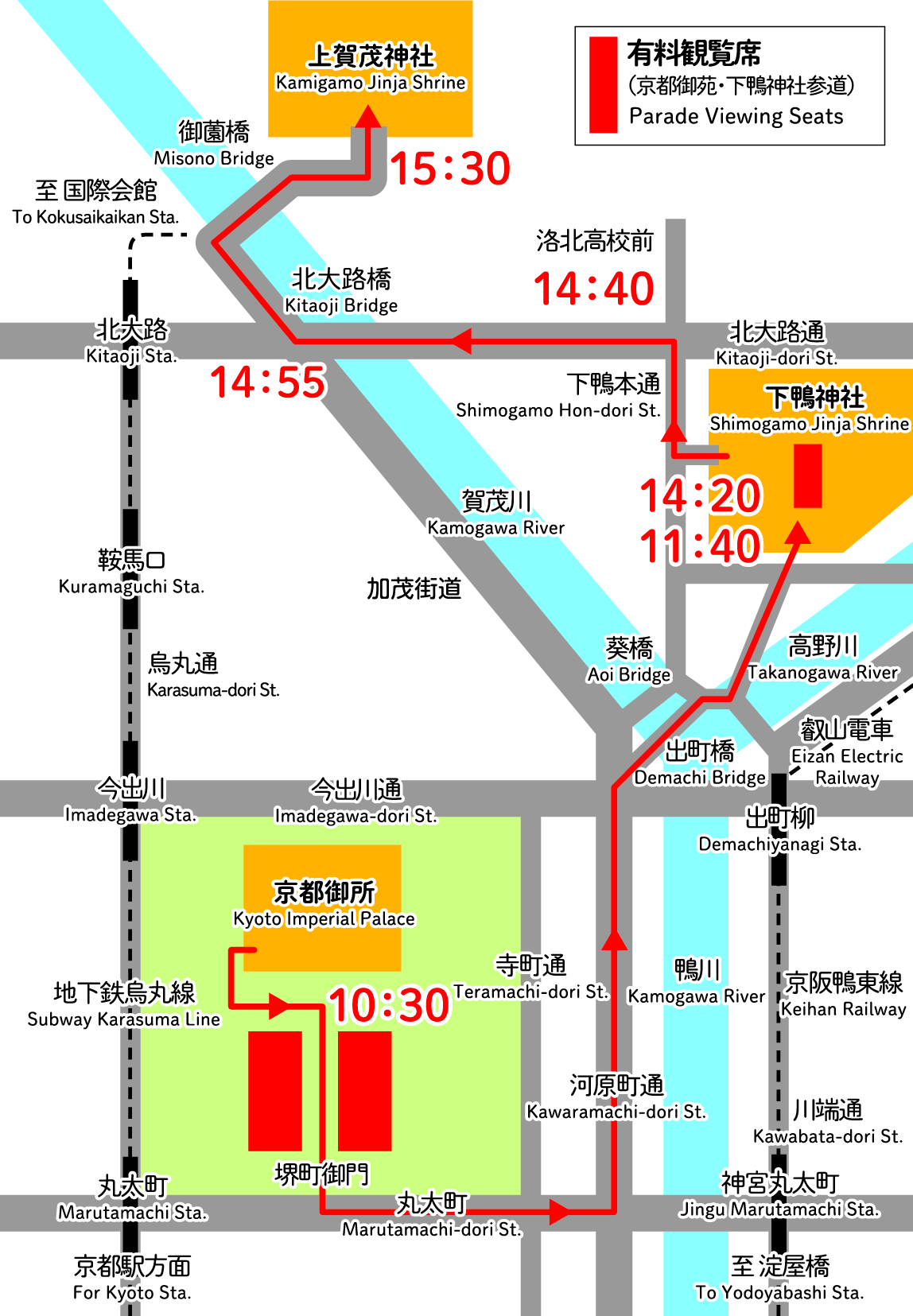
※The time stated above is the estimated arrival time of the head of the procession. For the entire procession to pass a single location takes about an hour. (Time stated above will be sometimes a little behind schedule.)
※Flash photography is prohibited. It may startle oxen and horses.
※Please beware when using city buses: traffic restriction is enforced around the parade route.
Major Viewing Spots & Access
・Inside the Kyoto Imperial Park
A short walk from Subway Karasuma Line “Marutamachi” Sta.
・The Intersection of Kawaramachi-dori St. & Imadegawa-dori St.
5-minute walk from Keihan Railway “Demachiyamagi” Sta.
・Shimogamo Jinja Shrine
(only limited space available besides the reserved seating areas)
10-minute walk from Keihan Railway “Demachiyanagi” Sta.
・Kitaoji Bashi Bridge
5-minute walk from Subway Karasuma Line “Kitaoji” Sta.
・Kamigamo Jinja Shrine
Detail of the Aoi Matsuri Festival Procession
The Main Group of the Procession: Honretsu
Norijiri
The leader of the procession riding on horseback. They served as jockeys in a sacred horse race held at Kamigamo Jinja Shrine on May 5th. The different colors of their jackets mean they were opponents in the race.
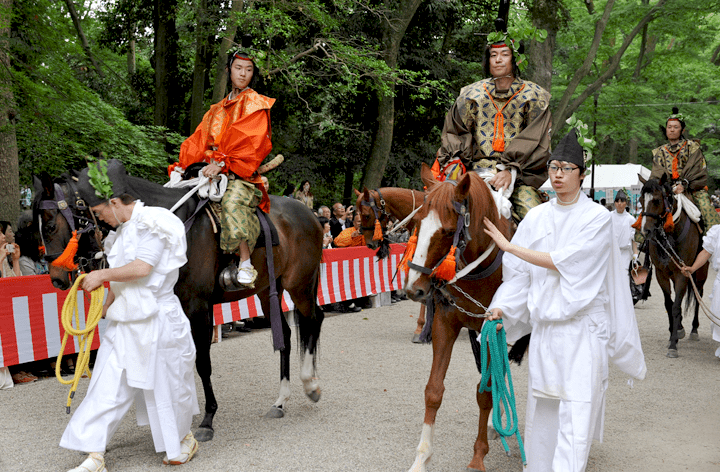
Suo
The forerunner in dress of a warrior of the Edo period (the 17th century).
Kado-no-Osa
An officer of the judiciary department and police in Heian-era Kyoto; equivalent to a police officer today.
Kebiishi-no-Sakan
Officers of old police and court administration. His atendant is carrying a bow and arrow.
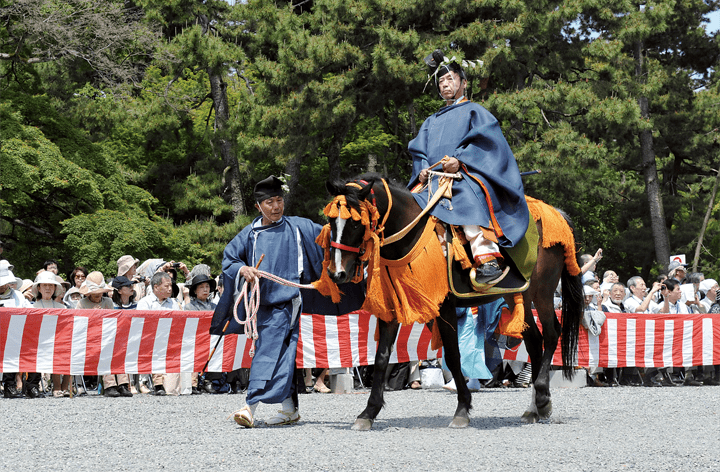
Eji
Soldiers usually entrusted with guarding the Imperial Court, tasked with protecting the chests in which the offerings to the deities are kept during the procession.
Kebiishi-no-Joh
An officer of the departament for police and judiciary in Heian-period Kyoto, shouldering the highest responsibility for procession security.
Yamashiro-Tsukai
Vice-Governor of Yamashiro (the old name of Kyoto Prefecture). As the procession passed the roads which were governed by the prefectural office, he joined the procession to guard it.
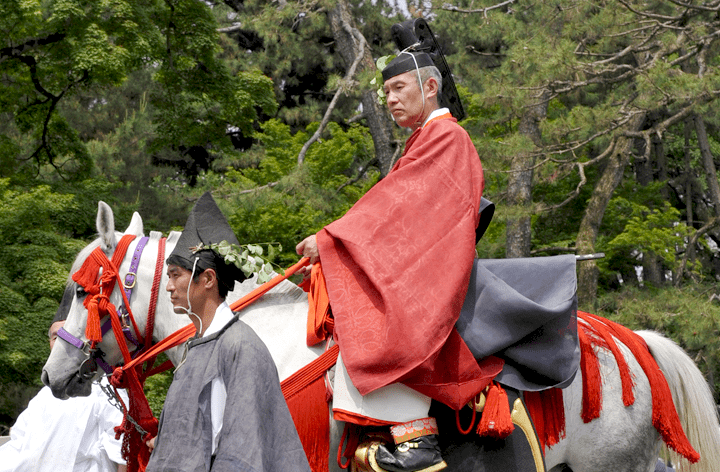
Goheibitsu (Chests containing ritual implements)
Three chests containing ritual implements carried from the Imperial Palace in order to be dedicated to the Kamo shrine deities. Two are offered at Shimogamo-jinja and one at Kamigamo-Jinja.
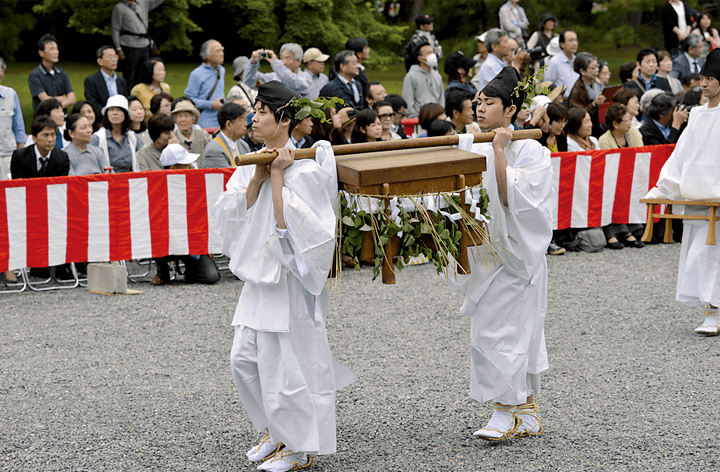
Kuraryo-no-Shisho
A government official who managed Imperial House assets. During the event he is entrusted with management of the ritual implements.
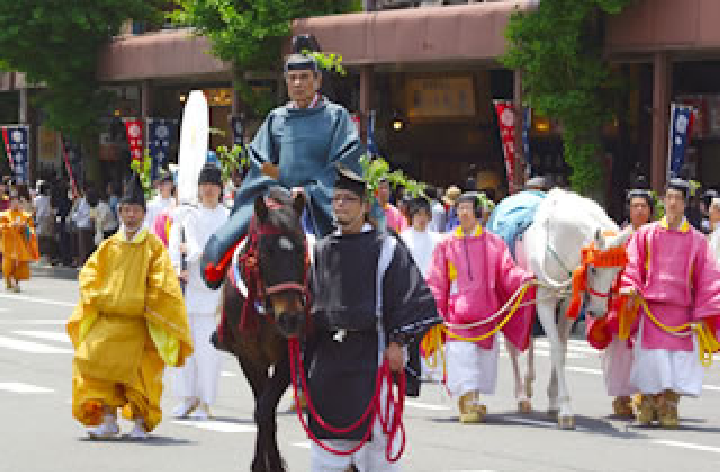
Meryo-Tsukai
Official responsible for the Imperial Court stables and the Sacred Horses (Ouma).
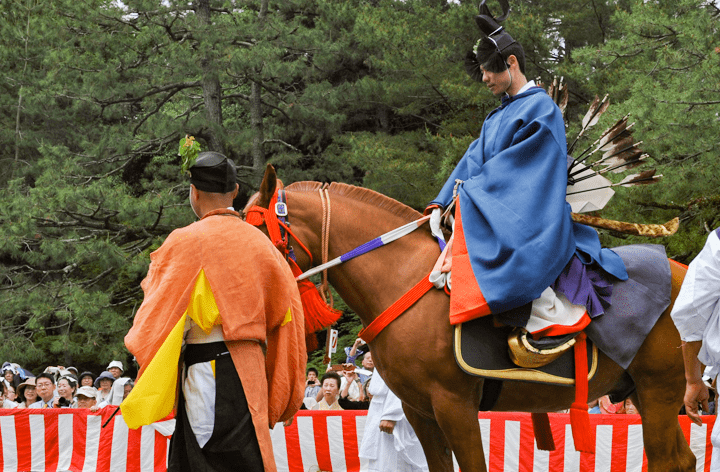
Ouma
The horses meant to be presented before the deities after the demonstration of them running in front of the shrines.
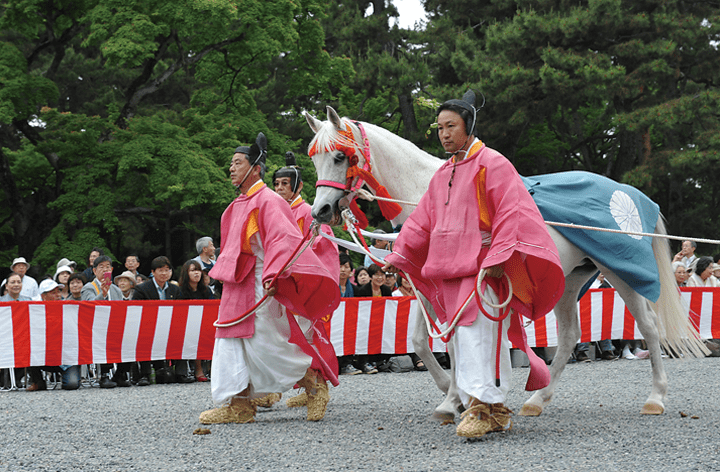
Gissha
This is a well-known carriage called “Gosho-Guruma”. Since the Heian period they were used for the transportation of Emperors and courtiers of high rank. Their roof and sides are colorfully decorated with wisterias, irises and plums. The carriage is pulled by an opulently decorated ox and moves very slowly, making squeaking sounds.

Maibito
These six warriors offer their dance in front of the shrine. In ancient times warriors were well-trained both in martial and cultural arts.

Beiju
The seven warriors who play music. They carry ancient musical instruments such as koto (Japanese harp).
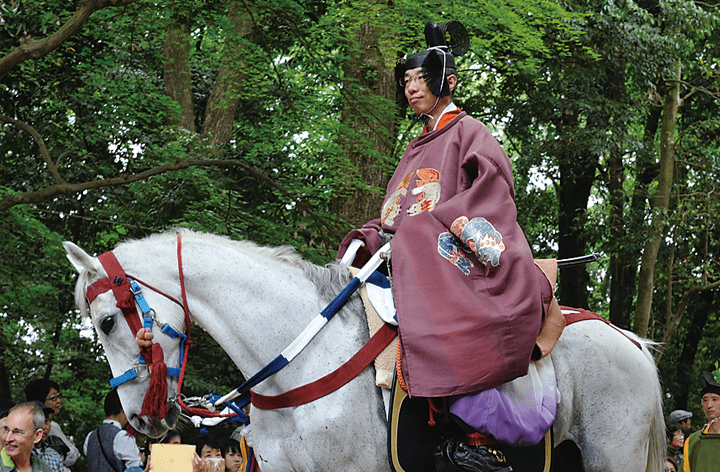
Kura-tsukai
Vice minister of the Kurayo, the departament responsible for managing Imperial Family assets. He is entrusted with the Imperial Script by the Emperor.
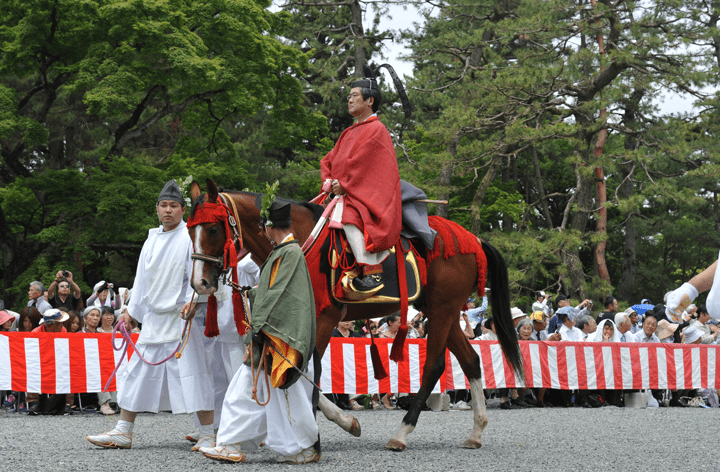
Konoetsukai-Dai
An imperial messenger carrying a sword decorated with gold, riding a horse.
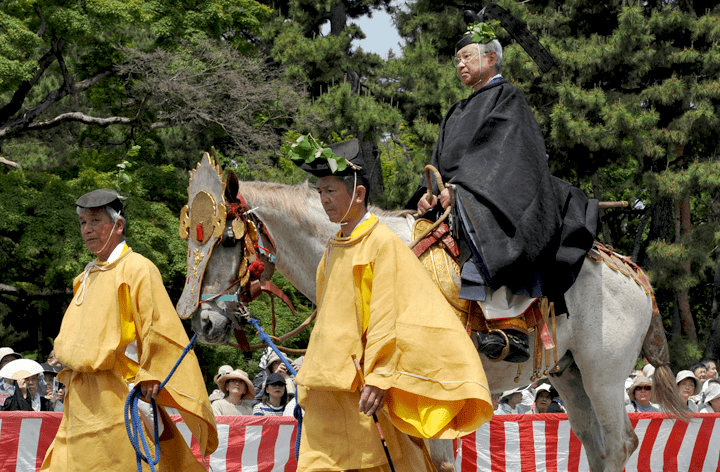
Hiki-uma
A spare horse for the imperial messenger, equipped with a saddle and stirrups of gorgeous lacquerware.
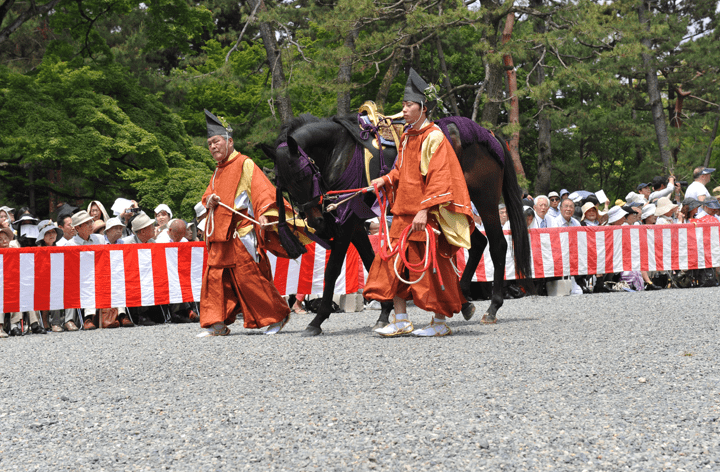
Furyu-Gasa
Big umbrellas, colorfully adorned with artificial flowers are carried by men who are decorated with the same materials. They are also called “Hanagasa” (Flower Umbrellas).

©Toru Miyake
Kuratsukai
A courtier who carries a ritual address which is to be read by the imperial messenger.
The Procession of Saio-Dai: Saio-Dai Retsu
Myobu
A lady-in-waiting belonging to one of the civic departaments in the inner palace, where the Empress lived. She is walking beneath a flower umbrella.
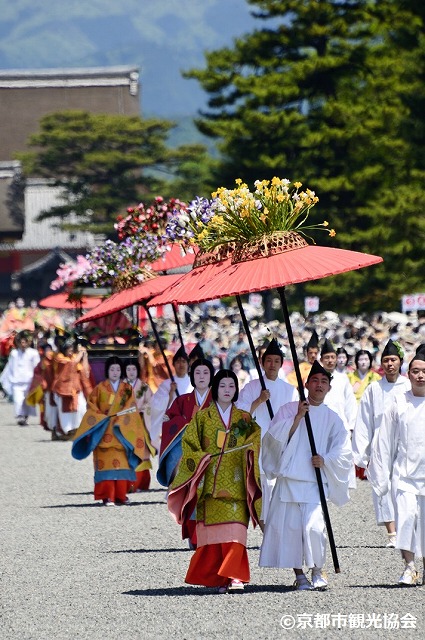
Saio-Dai
In the 8th century, the Emperor decided to appoint one of his daughters as a holy maiden who dedicated herself to the service of the deity.
Such princesses were called “Saio”. After completing harsh training, they became the head priestesses of the Shrine. The system of the “Saio” had lasted for almost 400 years until the middle of the 13th century. The head priestess is currently called “Saio-Dai”. She is seated in a palanquin carried on men’s shoulders. Suites, warriors, court ladies, carriages for high ranked court ladies and such follow her closely.
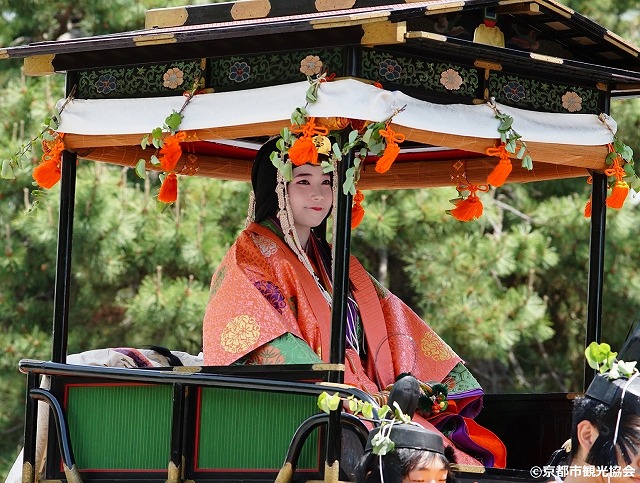
Munanori-Onna
Shrine maidens on horseback that follow Saio-Dai.
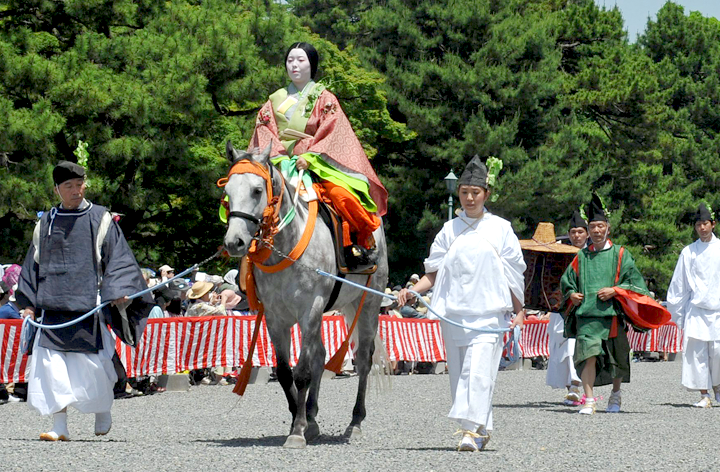
Onna-Betto
Official in the Office of the High Priestess of Kamo Shrines, responsible for supervising ladies-in-waiting and women in lower ranks. She walks under a flower umbrella.
Naishi
A Court Official managing lower-ranking women working in the palace. She walks under a flower umbrella.
Nyoju
Women tasked with preparation of meals in the palace.
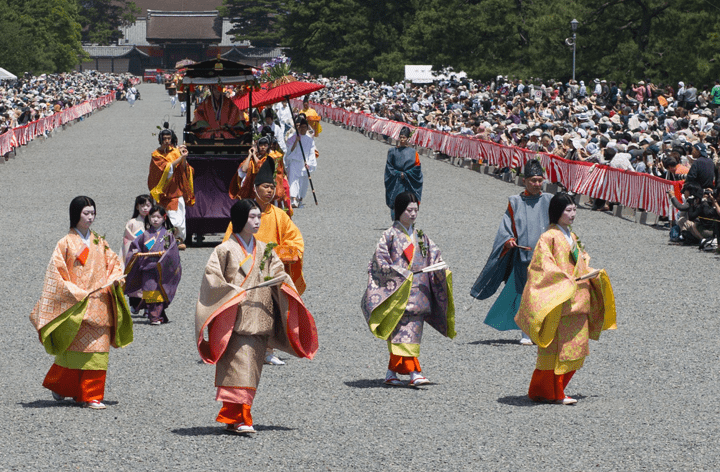
Uneme
A court official responsible for shrine rituals. The wave pattern on her attire is based on designs used by attendants to the Emperor and Empress between 16th and 17th century.
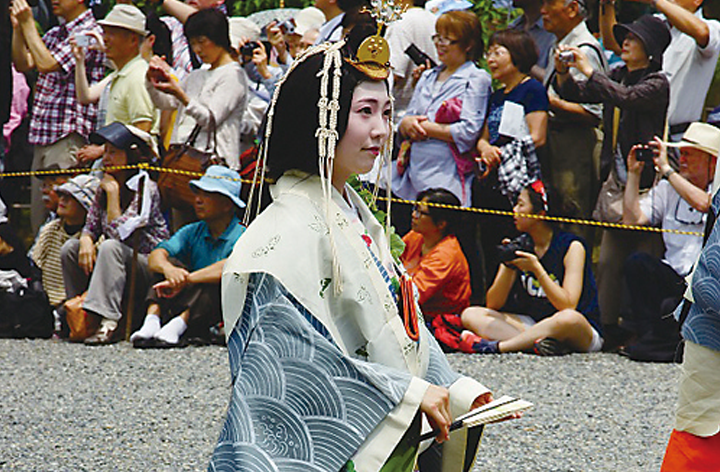
Kurodo-Dokoro-Beiju
An official responsible for inventory and accounting related to the Saiin – women of the Imperial Family who served as high priestesses at the Kamo shrines. He oversees performances of Court music and is accompanied in the procession by hand drum, sho (reed mouth organ), hichiriki (double-reed flute used in Shinto rituals), flute, large drum and gong.

Gissha for Saio-Dai Procession
Also called an “Eight-Leaf Carriage”, this ox-drawn carriage is decorated with hollyhock, katsura, cherry blossoms and other flowers and plants.
